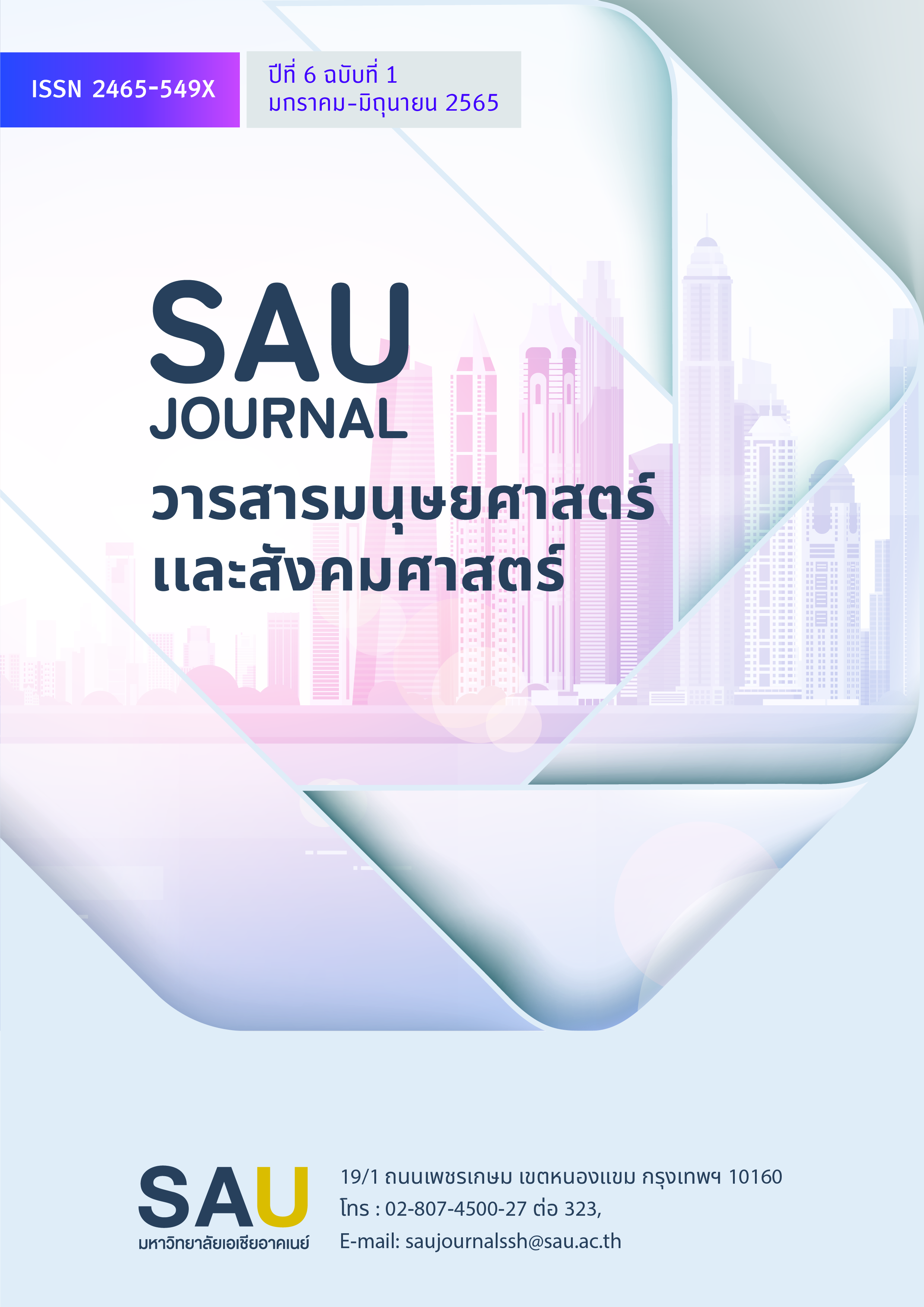การพัฒนาสมการพยากรณ์เกรดเฉลี่ยสะสมระดับปริญญาตรีชั้นปีที่ 1 ด้วยเกรดเฉลี่ยสะสมตลอดหลักสูตรมัธยมศึกษาตอนปลายที่มีรูปแบบการคัดเลือกเข้ามหาวิทยาลัยด้วยวิธีที่แตกต่างกัน
คำสำคัญ:
ความตรงเชิงพยากรณ์, เกรดเฉลี่ยสะสม, การคัดเลือกบุคคลเข้าศึกษาในสถาบันอุดมศึกษาบทคัดย่อ
การวิจัยนี้มีวัตถุประสงค์เพื่อ 1) ศึกษาผลสัมฤทธิ์ทางการเรียนของนักศึกษาชั้นปีที่ 1 ระดับปริญญาตรี 2) วิเคราะห์ความตรงเชิงพยากรณ์ของเกรดเฉลี่ยสะสมตลอดหลักสูตรมัธยมศึกษาตอนปลายหรือเทียบเท่า และ 3) พัฒนาสมการพยากรณ์เกรดเฉลี่ยสะสมของนักศึกษาชั้นปีที่ 1 ระดับปริญญาตรี ด้วยเกรดเฉลี่ยสะสมตลอดหลักสูตรมัธยมศึกษาตอนปลายหรือเทียบเท่า ประชากรและกลุ่มตัวอย่างคือ นักศึกษาชั้นปีที่ 1 มหาวิทยาลัยเทคโนโลยีราชมงคลกรุงเทพ โดยศึกษาข้อมูลทุติยภูมิจากนักศึกษาชั้นปีที่ 1 ประจำปีการศึกษา 2561-2563 จำนวน 7,392 คน เครื่องมือที่ใช้คือ แบบบันทึกข้อมูล สถิติที่ใช้ได้แก่ ความถี่ ร้อยละ ค่าเฉลี่ย ส่วนเบี่ยงเบนมาตรฐาน สัมประสิทธิ์สหสมพันธ์ การทดสอบที การวิเคราะห์ความแปรปรวน และการวิเคราะห์การถดถอย ผลการวิจัย พบว่า 1) ค่าเฉลี่ยผลการเรียนสะสมตลอดหลักสูตรมัธยมศึกษาตอนปลายหรือเทียบเท่าของนักศึกษาที่มีรูปแบบการคัดเลือกศึกษาต่อด้วยวิธีต่างกัน มีความแตกต่างกันอย่างมีนัยสำคัญที่ 0.01 โดยนักศึกษาที่ผ่านการคัดเลือกด้วยวิธีโควต้า ปวช. ปวส. มีค่าเฉลี่ยสูงที่สุด (M=3.38) รองลงมาคือ นักศึกษาโครงการความร่วมมือ (M=3.07) และนักศึกษาที่ผ่านการคัดเลือกด้วยระบบ TCAS รอบ Portfolio (M=3.03) 2) ความตรงเชิงพยากรณ์ของผลการเรียนสะสมตลอดหลักสูตรมัธยมศึกษาตอนปลายหรือเทียบเท่าเมื่อใช้เกรดเฉลี่ยสะสมในชั้นปีที่ 1 ระดับปริญญาตรีเป็นเกณฑ์ ในภาพรวมมีค่าเท่ากับ 0.422** โดยนักศึกษาที่ผ่านการคัดเลือกด้วยระบบ TCAS รอบ Admission มีค่าความตรงเชิงพยากรณ์สูงสุด (0.610**) รองลงมาคือ โครงการความร่วมมือ (0.561**) และ ระบบ TCAS รอบรับตรงร่วมกัน (0.538**) และ 3) สมการพยากรณ์เกรดเฉลี่ยสะสมของนักศึกษาชั้นปีที่ 1 ระดับปริญญาตรี (FGPA) ด้วยเกรดเฉลี่ยสะสมตลอดหลักสูตรมัธยมศึกษาตอนปลายหรือเทียบเท่า (HSGPA) มีค่าสัมประสิทธิ์การตัดสินใจ (R2) เท่ากับ 0.178 ซึ่งสมการพยากรณ์เป็นดังนี้
FGPA = 0.497** + 0.724**HSGPA
References
ชุติมา ใจคลาย. (2558). การออกกลางคันของนักศึกษามหาวิทยาลัยราชภัฏกาญจนบุรี. วิทยานิพนธ์หลักสูตร ครุศาสตรมหาบัณฑิต สาขาวิชาวิจัยและประเมินผลการศึกษา มหาวิทยาลัยราชภัฏกาญจนบุรี
ชูใจ คูหารัตนไชย และ สุจิตรา สุคนธมัต. (2563). “ความสัมพันธ์ระหว่างผลการเรียนในชั้นมัธยมศึกษาตอนปลายกับผลการเรียนในชั้นปีที่ 1 ของนักศึกษาสาขาสถิติประยุกต์ คณะวิทยาศาสตร์สถาบันเทคโนโลยีพระจอมเกล้าเจ้าคุณทหารลาดกระบัง”. วารสารวิทยาศาสตร์ลาดกระบัง. 29 (2),1-15.
ดำรงค์ เบญจคีรี และ คณะ. (2560). “ปัจจัยทำนายผลสัมฤทธิ์ทางการเรียนของนักศึกษาระดับปริญญาตรี ใน มหาวิทยาลัยมหามกุฏราชวิทยาลัย: การวิเคราะห์ถดถอยพหุคูณ พหุระดับ”. RMUTSB ACADEMIC JOURNAL (HUMANITIES AND SOCIAL SCIENCES), 2(2), 136-148.
นีลนารา ศรีสำราญ. (2558). “การเปรียบเทียบผลสัมฤทธิ์ทางการเรียนของนักศึกษาระดับปริญญาตรีคณะศิลปศาสตร์ มหาวิทยาลัยอุบลราชธานี ที่ผ่านการสอบคัดเลือกโดยวิธีรับตรงและวิธีรับผ่านส่วนกลาง ปีการศึกษา 2551-2554”. วารสารศิลปศาสตร์ มหาวิทยาลัยอุบลราชธานี, 9(2), 65-96.
ปวีณา ไชยชมพู. (2549). ปัจจัยที่มีผลต่อการปรับตัวของนักศึกษาพยาบาลมหาวิทยาลัยราชธานีวิทยาเขตอุดรธานี. วิทยานิพนธ์ศึกษาศาสตรมหาบัณฑิตมหาวิทยาลัยขอนแก่น.
เยาวดี รางชัยกุล วิบูลย์ศรี. (2553). การวัดผลและการสร้างแบบสอบวัดผลสัมฤทธิ์. พิมพ์ครั้งที่ 9. กรุงเทพมหานคร: สำนักพิมพ์จุฬาลงกรณ์มหาวิทยาลัย.
ราตรี ธรรมคำ (2560). “การศึกษาเปรียบเทียบผลสัมฤทธิ์ของการเรียนของนักศึกษาที่สอบคัดเลือกระบบรับตรง และระบบกลาง กรณีศึกษาคณะสิ่งแวดล้อมและทรัพยากรศาสตร์ มหาวิทยาลัยมหิดล”. Journal of Professional Routine to Research, 4 (สิงหาคม 2560), 9-17.
วรกมล บุณยโยธิน และคณะ (2561).”ความแตกต่างของระบบการรับเข้าศึกษาต่อผลสัมฤทธิ์ทางการเรียนของ นักศึกษาหลักสูตรอาชีวอนามัยและความปลอดภัย คณะสาธารณสุขศาสตร์ มหาวิทยาลัยมหิดล”. Journal of Humanities and Social Sciences Thonburi University, 12(29), 138-149.
ศิริชัย กาญจนวาสี. (2552). ทฤษฎีการทดสอบดั้งเดิม. พิมพ์ครั้งที่ 6. กรุงเทพฯ: โรงพิมพ์แห่งจุฬาลงกรณ์มหาวิทยาลัย.
สมนึก ภัททิยธนี. (2545). การวัดผลการศึกษา. กาฬสินธุ์: ประสานการพิมพ์.
สมาคมที่ประชุมอธิการบดีแห่งประเทศไทย. (2560). ประกาศกระทรวงศึกษาธิการ นโยบายการคัดเลือกบุคคลเข้าศึกษาในสถาบันอุดมศึกษาระบบใหม่ ปี พ.ศ 2560. เรียกใช้เมื่อ 01 09 2564 จาก http://www.cupt.net/
สำนักส่งเสริมวิชาการและงานทะเบียน (2564). สถิตินักศึกษา.เรียกใช้เมื่อ 01 10 2564 จาก http://www.ascar.rmutk.ac.th/system/?page_id=2886
อริสฬา เตหลิ่ม (2561). การวิเคราะห์ตัวแปรที่สัมพันธ์กับการเปลี่ยนแปลงระยะยาวของผลสัมฤทธิ์ทางการเรียน โดยใช้โมเดลโค้งพัฒนาการ. รายงานวิจัยฉบับสมบูรณ์. มหาวิทยาลัยบูรพา.
American Psychological AssociationA (2021). APA dictionary of Psychology. เรียกใช้เมื่อ 10 09 2021 จาก https://dictionary.apa.org/
Angoff, W. H. (1984). Scales norm and equivalent scores. เรียกใช้เมื่อ 20 09 2021 จาก https://www.ets.org/Media/Research/pdf/Angoff.Scales.Norms.Equiv.Scores.pdf
Arce, M.; Crespo, B.; Míguez-Álvarez, C. (2015). Higher Education Drop-Out in Spain: Particular Case of Universities in Galicia. International Education Studies (IES). 2015, 8, 247–264.
Cabrera, A.F et al (2006) , R.E. Feature articles: Theory, research, policy and practice: Increasing the College Preparedness of At-Risk Students. Journal of Latinos and Education. 2006,5, 79–97.
Camara, W. J., & Echternacht, G. (2000). The SAT I and high school grades: Utility in predicting success in college. Research notes, 10.
Fletcher, J. M., & Tienda, M. (2009). High School Classmates and College Success. Sociology of Education, 82(4), 287–314.
Flanders, G. R. (2013). The effect of course completion within selected major on persistence for freshmancollege student. Doctor dissertation, Business Administration, University of Phoenix
Hoffman et al. (2005). “Predicting College Success with High School Grades and Test Scores: Limitations for Minority”. Review of Higher Education, 28 (4), 455-474.
Kaplan, R. M., & Saccuzzo, D. P. (1997). "Psychological testing: Principles, applications, and issues. Pacific Grove, CA: Brooks.
Linn, R. L. (1993). Linking results of distinct assessments. Applied Measurement in Education,6, 83-102.
Talento-Miller, E., & Rudner, L. M. (2008). “The validity of Graduate Management Admission Test scores: A summary of studies conducted from 1997 to 2004”. Educational and Psychological Measurement, 68(1), 129-138.





